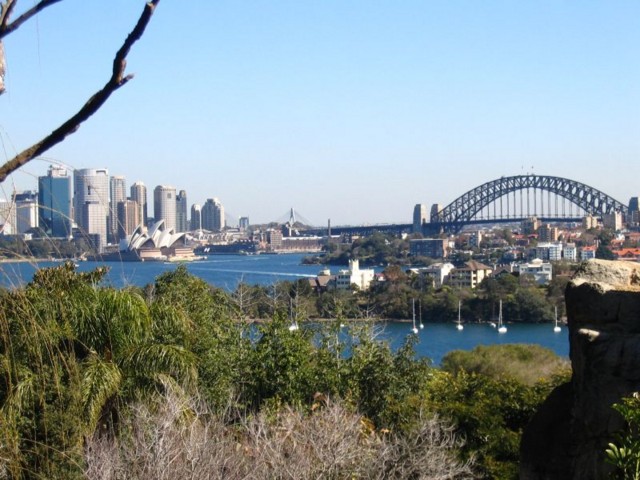
The Sydney Opera house is, without a doubt, the most famous building in Sydney. It is also the most prominent, most distinguishing feature of the city. It is most distinguishing because, whereas the harbour bridge can be confused with many other bridges in this and other continents, the opera house looks like nothing else on earth. It is most prominent because you can see it from anywhere and everywhere in the city.
We saw it every day, coming by bus from the house in Cremorne to the city, as well as on the way back. We saw it when we traveled northward by train. I even saw it from Mrs. Macquarie's chair, which is not very far from Russell Crowe's Australian residence, meaning that he can probably get a glimpse of it every morning when he's in town. In fact, our most spectacular pictures of the city, showing both the opera house and the harbour bridge were taken from Taronga zoo.

However, only in four occasions did we have a chance to look at the opera house up close. And when I say, up close, I mean close enough for you to see that the house is not really white. Its outside is really made of tiles that are off-white and shale, and is so by design, so as not to be too bright to look at directly.
The first of our visits to the opera house was when we came to buy tickets to a dance performance at the opera house. It was a show called "Boomerang" that was a modern dance inspired by Aboriginal culture and featuring Aborigine dancers. Na'ama saw a previous show of theirs that was called Bush and said that they were very good, so, of all the various things that the opera house had to offer, this is what we chose to see. Personally, I was looking forward to it because it was my first real encounter with Aborigines and their art (with the exception of the digeridoo players on Circular Quay, who play for change, who I don't think really count for this purpose).
The last visit we made to the opera house was when we actually came to watch this performance, so these two visits framed our close-up views of the opera house.
Between these two visits was our whale-watching nightmare, where we passed right by the house and took great outside shots of it.
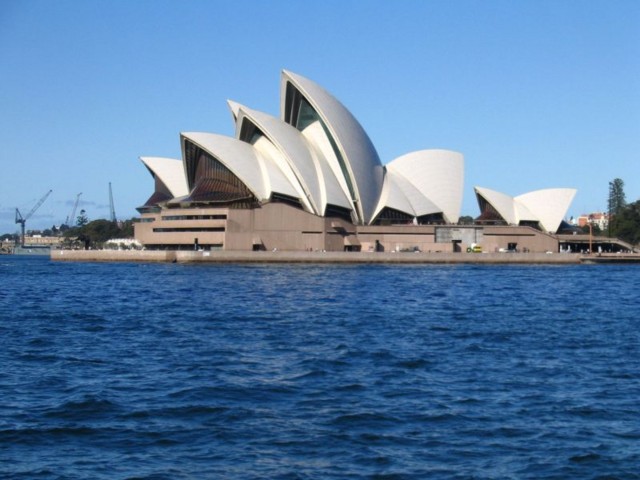
The second, only a day later, was when we came to the opera house, and were able to take, from it, pictures of whale-watching tourists on their way to meet Moby Dick.
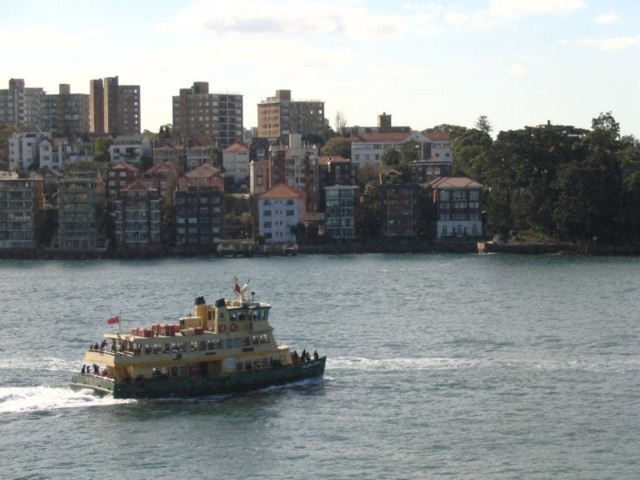
This picture was taken from one of the many glass-walled areas within the opera house.

Our tour guide mentioned that this area is sometimes used for special occasions, and, indeed, the tables were being arranged for one as we stood there. Orit, not wasting a second, immediately asked the tour guide how much it would cost to hold one of these occasions here.
He asked: "What sort of an occasion?"
She, without blinking, answered: "A Brith."
He, still undaunted: "How many invitees?"
At which point Orit became nonplussed and the staring competition was over. I'm sure that if she had answered that question, he would have asked her what she wanted on the menu. In any case, he ultimately gave us some price ranges, and directed Orit to the management office, if she had anything specific in mind and a million spare dollars in her pocket.
Little did we know that as we stood there in the opera house, the tables were being set for an event that was being held at strictest confidence, but will be the talk of every newspaper and television show for the remainder of the week. This event was the marriage of Bec Cartwright (one of the stars of "Home and Away" [KAROV RACHOK], according to the newspapers) and Layton Hewitt (a tennis player and Australian icon, it would seem).
This may be a good time to mention sports, before returning to the Sydney Opera House and its treasures. Australians are a nation mostly characterized by their great need to compete. Sports-people are considered celebrities on the same caliber as politicians and movie-stars and perhaps even higher. However, every pyramid must have a pinnacle, and for Australians there is one sport that is above the rest. This is the one game, the mother of all games, the game that Australia has embraced as its own - this is the Australian Rules Football, a.k.a. Aussie Rules Football, a.k.a. Footy, which, confusingly, is a variant of rugby, not of soccer.
Footy players, in Australia, are regarded as national heroes. News broadcasts in Australia are 90% about footy and 10% about everything else. To give an example (though perhaps not a very good one), two days after our visit to the opera house, Na'ama invited me to watch a bit of news on TV. They spoke about the latest scandal that one of the footy players was involved in. Then they said: "In other news, James Doohan, better known as Star Trek's engineer 'Scotty', died today from pneumonia and Alzheimer's disease. And now back to sports."
Incidentally, those of you trying to follow the dates of all these happenings will realize that James Doohan actually died on the 20th of July, whereas this news broadcast was on the 21st. This is quite typical for Australia. Their overseas news is always a day late. Na'ama says that this is because of the time difference, but I think that news just takes its time crossing the ocean, and Australians, with their laid-back attitudes to life, take their time receiving them. Unlike Douglas Adams's hypothesis, not even bad news travels faster than light.
Anyway, when the conversation turns to footy, the true nature of Australians is revealed. We were, later on in the trip, with a group of a dozen people whose average age was seventy, but when footy came up you suddenly realized that every old grandmother is really a rabid fan of either this team or that. Unbelievable, really.
But I'm getting ahead of myself. We were all still back at the opera house, enjoying a great view through glass windows that are tilted in forty-five degrees in order to minimize the glare.
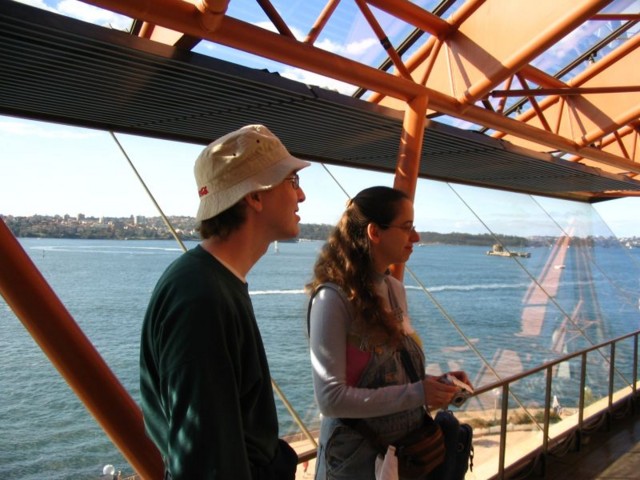
In the background, by the way, you see yet another landmark of Sydney. This is Fort Denison.

It, too, can be seen from anywhere in Sydney.
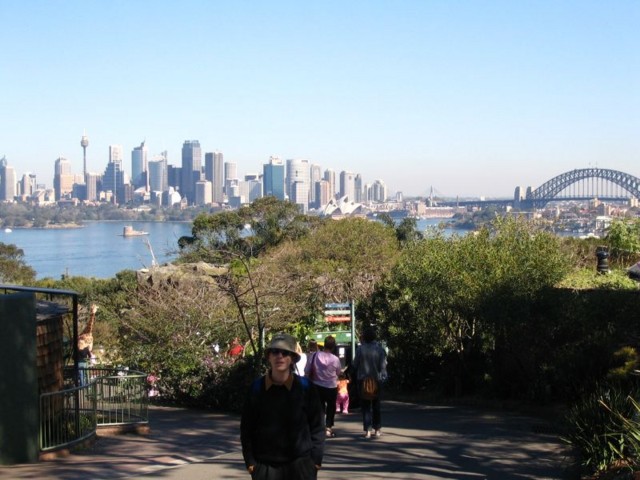
Historically, this is the place in Sydney to which convicts were originally brought. The place had many guards on it, but only one with a rifle. The idea behind this was as follows.
Suppose some convict takes control of the gun and kills everyone else on Fort Denison. He'll still find himself on an island with no food. Trying to swim to shore is akin to suicide: the water is freezing cold, the currents are deadly and sharks abound. However, even if that hypothetical convict manages, risking life and limb, to reach the shore, what then? There is only one known sweet-water supply in the area, and that, unlike the island, is where all the men with guns are...
Other fun facts about Fort Denison:
But let's get back to the opera house, as it is interesting enough on its own right.
The Sydney Opera House has many anecdotes worth telling, most about its construction. In fact, one could say that there are enough stories about the construction of the Sydney Opera House to merit an opera. But then again, there actually is an opera that was written about the house's construction. Moreover, it was even performed in the Sydney Opera House (and, like so many other things to do with the construction of this edifice, it was a complete flop).
In any telling of the construction of the Sydney Opera House, the main character, our protagonist, will be Jorn Utzon. Jorn Utzon - actually Jørn Utzon, but let's skip that - a Copenhagen-born architect, received the contract for the construction of the Sydney Opera House in 1956, when he was only 37. His design, which won the opera house design competition and got him the contract, was an ingenious solution to the problem of how to build a two-theater opera house (a big theater for operas and a smaller one for concerts) when the house you're building is exposed to the viewer on all sides. Opera houses usually have very decorated fronts that hide a massive wall in their rear, which, in turn, hides all the volume needed. When your building is on a peninsula quite as exposed as Bennelong point, this solution no longer works. Utzon's design, unlike all other contenders, solved this problem elegantly, by constructing a house with no walls, a house that is all ceilings. The genius of this was recognized by Eero Saarinen, a visiting American architect, who was asked to pick a winner for the competition, after the panel originally chosen for this purpose came back empty-handed.
The story of the construction of the opera house is a tragedy, and Utzon is its tragic hero. A good overview of what happened can be found here, but I'll try to briefly overview it.
The scene is 1956 Sydney, which is very different than the Sydney we know now. It is a very small city, overshadowed by Melbourne. Bryson states that there were, back then, only 800 hotel rooms in the entire city, and Bennelong point, the place where the opera house now stands, was a municipal tram garage.
The catalyst, which throws all later events into motion, is the announcement that Melbourne was chosen to host the 1956 Summer Olympics. Clearly, Sydney had to do something and Sir Eugene Goosens, head of the Sydney Symphony Orchestra, knew what that something should be. He wanted a concert hall, as Sydney didn't have any decent place to hold one.
We start, therefore, with a group of good, well-meaning people: Utzon, Saarinen, Goosens, and, last but not least, the opera house's greatest supporter and friend, the man who took all this potential and turned it into action, the then state Premier of New South Wales, John Joseph Cahill, after whom locals still, to this day, refer to the opera house as the Taj-Cahill.
Sadly, from this promising beginnings, things deteriorate rather quickly, and soon trouble begins piling up.
Utzon was then a young and inexperienced architect. In fact, to this day he has very little to his name that has actually been built, and certainly nothing on the grand scale of the Sydney Opera House.
Cahill was a Premier who managed to get into office by a thin majority in 1956, and was afraid to be pushed out in the 1959 election unless Utzon was able to show some results. For this reason, the house's greatest friend exerted extraordinary pressure on Utzon to begin construction as early as possible.
Utzon, ultimately, was willing to compromise. He got the opera house contract in 1957 and was willing to start, by 1959, the construction of the platform on which the opera house will stand. The house itself - Utzon was firm on this point - would not be hastened.
On 2 March 1959, Cahill laid the first stone of the building. Whether he won the election or not is immaterial, because he died within the year.
Goosens, too, was soon off the project. An anonymous phone call instigated the searching of his luggage when he arrived at Sydney airport (an unheard-of procedure back then). The luggage proved to contain paraphernalia for the Black Mass of a pornographic nature. Though, today, this would have not raised any inspector's eye-brows, back then it cost a heavy fine, cost Goosens the conductorship of the new Sydney Symphony Orchestra, and forced him to return to England. He never saw the finished building or any part of it, and would later claim that he was blackmailed into bringing all these things.
Technical problems now began to arise. I will mention one. It is far from the only one or the most troubling one, but it is the most famous one and serves to exemplify all others. The billowing roofs of the house looked very good in the sketches Utzon drew for the competition, but now that real planning had begun, it became apparent that the angles were much too steep, and the roof was too heavy to be supported by any of the originally planned means. It was not until 1961 that Utzon finally saw the solution of how to make such a roof hold. He decided to build the outer shape of the house as parts of a sphere. This was a great relief to everyone who began to think the project was impossible (which it almost was), but created several problems of its own.
First, it made the roof no longer acoustically convenient, and spurred an entire new bout of technical impossibilities regarding the internal design, with new groundbreaking solutions. Second, and more importantly, once the roof design is changed, the platform, which was now in construction for two years, was no longer strong enough to support it. A new platform had to be built.
Here comes to first of two anecdotes about the Sydney Opera House that, I believe, characterize Australia as a whole.
The construction of the building was supposed to cost roughly five million dollars and be finished in five years. They were, at this time, two million dollars into the spending and two years into the project. Two million dollars is a lot of money, especially by the standards of the early 1960s, but there was no solution other than to take dynamite and blow the whole thing into smithereens, starting all over again from scratch.
The Sydney Opera House is not a place hidden away. As mentioned, it can be seen from everywhere in the city, and there are a lot of tax-payers who would see two million dollars of their money going up in flames. Everybody involved thought they would be lynched.
So, they came up with a solution that rivals even the genius of spherical roofs. They decided to blow it up on a Friday afternoon at two p.m.. This is a time - to quote our tour guide of the Sydney Opera House - which every Australian spends in philosophical musings regarding which pub to go to and which girl to invite there.
So, Friday, 2:00p.m. arrives. The harbour bridge, overlooking the under-construction Sydney opera house is crammed with a traffic jam and would-be onlookers abound. Boom!
Not a single letter of complaint arrived.
You gotta love Australia.
In any case, Cahill's death in 1959 did not leave a void in the political map forever. Though Cahill's party did manage to skate by until 1965, ultimately they were defeated, and the new State Premier, Robert Askin, stepped into play.
Askin - like all politicians everywhere in the world - was more interested in embezzlement than anything else, and a huge spending project of the sort lead by Utzon did not fit with this plan. By then, the project was eight years into its alloted six-year run and roughly 25 million dollars in the spending.
Add to this stew a guy called David Hughes, Askin's minister for public works, who believed "that 'public works' meant sewers, dams and bridges", and who, consequently, was to become Utzon's personal nemesis, and you will see why in 1966, only a year later, Utzon was maneuvered off the project.
He, too, would not see the construction of the house completed. Only in 2002, when the Australian government, trying to make amends over making him a political scapegoat forty years earlier, offered him to design a new room in the Sydney Opera House, would he see the building for the first time.
The project was taken over by three Australian architects (Lionel Todd, David Littlemore and Peter Hall), despite overwhelming public protest. The rest is the unavoidable outcome:
The project ultimately took three times its appointed length and cost 107 million dollars instead of the expected five, and to this day it is considered by many to be a design-by-committee product. Nobody is quite sure, for example, why despite Utzon's brilliant solution to opera house construction, the place is still unsuitable to perform operas on. Technically, nobody built enough back-stage room for it, but was the flaw in Utzon's design or was it a later problem?
To make these debates even more confusing, it turns out that when Utzon slammed the door shut on his way out from the project he took with himself all architectural drawings and plans. Apparently, in their haste and their wish to save money, the NSW government never bothered buying these from Utzon. So, in 1966 they were stuck with a half-finished construction and no idea what it really looks like, what's inside it, and how it was planned to continue.
At this time, all of the outside of the building was fully erected, and none of the inside was. Todd, Littlemore and Hall decided to solve this conundrum in a brilliant solution of their own: they would build a house within a house. Hence, if you enter the Sydney Opera House, you will find that all of its interior is in a completely different style than its exterior, the interior is a building entirely of its own, and nowhere do the inside and the outside walls touch.
The second anecdote about life-style in Australia that can be exemplified in the story of the Sydney Opera House has to do with its funding. Nobody expected this project to take up 107 million dollars. This was huge money back then, and nobody knew where to take it from.
Until, that is, they realized that they were all living in Australia and that Australians love gambling almost as much as they love competing. Hence, the Sydney Opera House Lottery was founded, where the grand prize for the winner was an imaginary 2.5M$. The opera house was fully paid up for in no time flat.
Anyway, that's the short version of the construction of the Sydney Opera House. As you understand, I was paying close attention, because I thought it is fascinating. In the words of the web page I referred to earlier: "It is a bittersweet story, and one that goes far to explain why most modern architecture is so awful."
Orit and Na'ama, on the other hand, were more impressed by this:

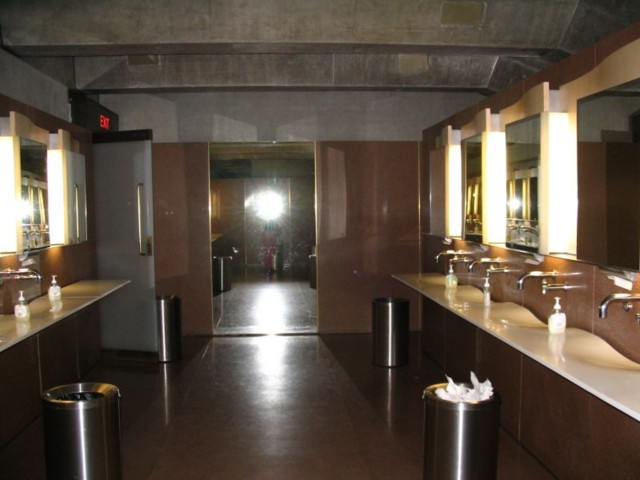
Yes, these are the bathrooms. We didn't get to see them on the tour, but they were a must-see piece according to Na'ama. The surfaces are dark, quite unlike conventional bathrooms. The illumination is indirect and based on hidden light sources reflecting from strategically placed bright surfaces, such as light-colored wood. The sinks are liquid, rolling shapes, the utility of which is overshadowed by the geometrical design. In short, this is a reflection of all the design of the interior halls of the opera house. If you imagine a theater design with this same concept in mind, you'll have the general idea of what they look like.
I, personally, was more impressed by the large concert hall than by the bathrooms. When we came in, there was a quartet or quintet there, in practice, and the acoustics of the place are nothing less than amazing. In terms of "things to see", what catches the eye immediately is the pipe organ. Imagine a large concert hall, with room for a full orchestra and thousands of seats. Now, imagine that one entire wall is dedicated entirely to a pipe organ, with pipes running from way below the seating level to high overhead. This is the largest pipe organ in the world. It has no less than six keyboards, though it is played entirely by a single person. Don't ask me how this magic trick is done.
And that's the opera house, where no opera is likely to be performed any time soon.
Our fourth time at the house, and our final farewell of the place, was when we came in to see "Boomerang". We were very late in coming in, and had to run in order to get there before the doors closed. You can't be late in for a show at the opera house. With the halls being so dark (see the bathroom pictures for an idea) late entries would be highly inconvenient for all people in the show. So, instead, latecomers are simply sent back home empty-handed. We didn't want to count among them.
No sooner had we sat down than the lights went out. Barak had just enough time to say "wake me up when it's over", and then the show started. (I was not fooled by this statement, however, as I saw him watching the entire show intently.) Unlike Barak, Orit had no trouble admitting that she wanted to see the show. She had no trouble, in fact, saying this to the woman sitting in the row in front of her. Her words, if I remember them correctly, were "Can you please lean back or flatten your hair? I'm trying to watch the show." The woman was shocked beyond words and quickly leaned back before risking further remarks from Orit.
Art being art, there is no point in trying to describe what actually went on, on the stage. The important thing is not what happened on the stage, but rather what went on in our minds, and this I will try to convey by describing our conversation after we left the show. We sat in a small cafe, two minutes away from the opera house, and discussed things over a light dinner.
I was commenting on the fact that the choreographer of the troupe is, in fact, not Aborigine at all (a fact I checked before we saw the dance). I said that what we saw was, in my opinion, not an Aboriginal or Aboriginal-like dance, but rather a European dance, with European structure, themes, language, etc., and only the actual "words" used, that is the specific body-language symbolism, was imported from Aboriginal dance. In my opinion, I said when we were in the cafe, this is not a bad thing. It makes the Aboriginal elements accessible to people like me, who are not versed with the Aboriginal forms of communication, dance or otherwise. I offered some interpretations of what I saw there, in terms of these elements, but at that point Na'ama had to intervene.
Na'ama was very well versed with Aboriginal dance, and gave much better interpretations than I did to that aspect of the performance. She didn't seem at all influenced by the European framework of the performance, but, instead, compared it with other Aboriginal dances she is familiar with, with Aboriginal art in general, with "Bush", the last show of this same troupe (though, evidently, they made many personnel changes since that last show), and even with dances of other quote-unquote "primitive" civilizations. She interpreted what we saw as dances that literally try to recreate events such as "hunting", "fishing" and "gathering plants". Various actors perform the various "roles" in these acts, animate as well as inanimate, so, for example, when the dance is "cooking", someone must be playing the meat. However, even Na'ama did not overlook the fact that we were presented with a frame story that is entirely non-Aborigine in nature. Dances, in Aboriginal culture, are meant, among other things, to teach children and lead them into adulthood. In Boomerang, we were shown not only the dances, but also a framing story of a boy who is being ushered into the world of adults through them.
Barak's point of view was very different than both my view-point and Na'ama's. Barak was being Barak. That is, his objections to what we saw were
I will try to present these here as coherently as I can (which is quite possibly more coherently than they were originally relayed to me), and if this is not the jest of Barak's argument then I apologize in advance. What I remember him saying is "I don't know why they feel the need to jump up and down like that, and I don't know why they think that I should feel the need to watch them do it". I think this came as part of an argument along the following lines:
"If this is an Aboriginal dance, why does it need to be performed at the opera house? If it is about teaching the next generation, why perform it to me, as I am not even an Aborigine."
"Regardless of the fact that it was performed by Aborigines, what's the point in dances at all? What does one gain by watching them? Are they a form of art? If so, how do they rate in the terms in which we usually measure art? They certainly don't elate my spirit, as I am only bored by them. Are they a form of communication, e.g. a communication of Aborigine traditions to European viewers? If so, why can't they just say what they mean, and be done with it? Why does it have to be performed under the general guise of 'art' instead of Aboriginal studies?" etc..
Finally, the fourth person at the table, Orit, was the most concrete and consistent. Her dilemma was between ordering the pie and ordering the ice-cream, and ultimately she came to the conclusion that ice-cream would probably be a better choice. I tend to agree with that viewpoint.